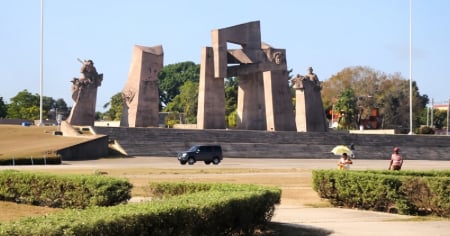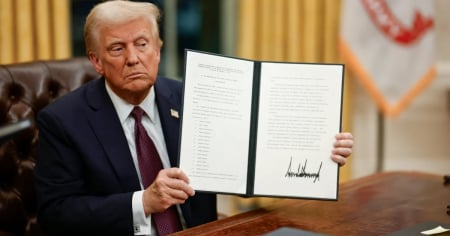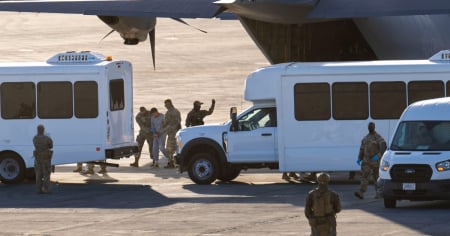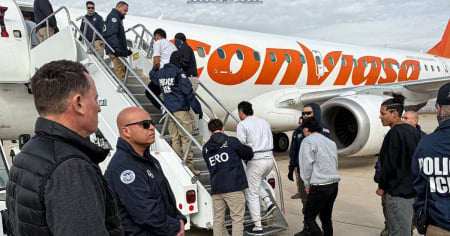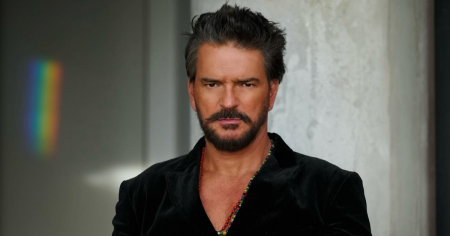The government of President Trump decided to remove all undocumented immigrants that it held at the Guantánamo Naval Base to eliminate the need for a temporary court order and to respond to legal challenges questioning the detention conditions and the rights of those held there.
The Department of Justice defended the operation to release immigrants, arguing that the detention in Guantanamo was of a “temporary, not indefinite” nature, according to the agency AP.
He also reiterated that by emptying the immigration center, the need for emergency judicial measures requested by human rights advocacy organizations was eliminated.
Additionally, the government assured that the procedures for accessing legal counsel would remain available for the transferred detainees.
The Trump administration also responded to a lawsuit filed by the American Civil Liberties Union (ACLU) and the Center for Constitutional Rights, arguing that immigrants in Guantánamo did not have “the same constitutional protections as U.S. citizens” and therefore did not have the right to legal assistance on equal terms.
The relocation of immigrants and the temporary suspension of detentions
The operation concluded on Thursday with the airlift of nearly 200 Venezuelan immigrants back to their home country, bringing an end to the presence of immigrants in the controversial center.
However, satellite images confirm that the facilities of the Base are being expanded, as revealed by the network Univision.
Although Guantánamo was initially designed to house prisoners of war and terrorism suspects, in recent years it has been used as a temporary detention center for immigrants with deportation orders.
In total, the government reported that in recent weeks there were 178 immigrants detained in the facility.
Of them, approximately one third were classified as “low threat” due to a lack of serious criminal records and were housed in the “Migration Operations Center,” a less secure area of the facility.
The remaining 128 immigrants, considered to be of "high threat," remained in Camp IV, a maximum-security facility with a capacity for 175 individuals.
However, due to maintenance work, the facility only housed 131 detainees at that time.
Criticism and denunciations from human rights organizations
Human rights organizations reported that the detention conditions violated the fundamental rights of immigrants.
The lawyers from the ACLU and the Center for Constitutional Rights stated that the detainees were in a "black box," without contact with their families, access to a fair trial, or adequate legal representation.
Jennifer Babaie, director of legal and defense services at the Las Américas Immigrant Advocacy Center, reported on the conditions in Guantánamo, asserting that “many of the detainees had already been subjected to abuse and violations of due process.”
According to Babaie, keeping immigrants isolated without access to their lawyers or family members constituted a serious violation of their rights.
The government's defense: Security and criminal links
The Trump administration justified the use of Guantanamo for the detention of immigrants with possible ties to criminal organizations, such as the Tren de Aragua.
The Secretary of Homeland Security, Kristi Noem, stated that those detained were “the worst illegal criminals,” although many of the immigrants had not been charged with serious crimes.
The government's lawyers argued that, although the detainees did not have the same legal protections as U.S. citizens, they were granted limited access to lawyers through phone calls and correspondence.
However, the government admitted that in-person visits were prohibited.
The use of Guantánamo as a detention center for immigrants raised international concerns. Humanitarian organizations warned about the risks of abuses in an isolated and unsupervised detention facility.
The conditions of the facility and the restrictions imposed on the detainees were viewed by many as a violation of international human rights standards.
Finally, with the recent deportation, the Trump administration is temporarily closing the chapter on Guantánamo as an immigration detention center. However, the expansion of the facilities could indicate that this is only a pause.
Frequently Asked Questions about the Deportation of Immigrants to Guantánamo
Why did the Trump administration decide to remove all immigrants from Guantanamo Bay?
The Trump administration removed immigrants from Guantanamo Base to avoid temporary court orders and legal claims that questioned the conditions of detention and the rights of those held. The administration argued that the detention was temporary and that by emptying the facility, the need for emergency judicial measures was eliminated.
What criticisms have the detention policies in Guantanamo received?
Detention policies in Guantánamo have been criticized by human rights organizations, which have reported violations of immigrants' fundamental rights. Lawyers from the ACLU and the Center for Constitutional Rights stated that the detainees were isolated without access to a fair trial or adequate legal representation, which constitutes a serious violation of their rights.
What arguments did the Trump administration use to justify the use of Guantanamo as a detention center?
The Trump administration justified the use of Guantanamo by citing possible connections between the detainees and criminal organizations, such as the Tren de Aragua, arguing that some immigrants were "the worst illegal criminals." However, many had not been charged with serious crimes. The government also highlighted that limited access to lawyers was provided.
How has the Cuban government reacted to the use of Guantánamo for the detention of migrants?
The Cuban government has strongly rejected the decision to use Guantánamo for the detention of migrants, labeling it as "brutality" and warning of potential "serious consequences" for regional stability. Cuba believes that the base is located in territory that has been illegally occupied by the United States.
Filed under:

